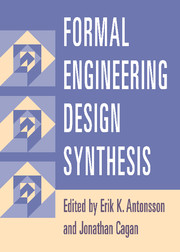Book contents
- Frontmatter
- Contents
- Contributing Authors
- Foreword
- Preface
- Introduction
- 1 Vitruvius Redux
- 2 How to Calculate with Shapes
- 3 Engineering Shape Grammars
- 4 Creating Structural Configurations
- 5 Microsystem Design Synthesis
- 6 Function-Based Synthesis Methods in Engineering Design
- 7 Artificial Intelligence for Design
- 8 Evolutionary and Adaptive Synthesis Methods
- 9 Kinematic Synthesis
- 10 Systematic Chemical Process Synthesis
- 11 Synthesis of Analog and Mixed-Signal Integrated Electronic Circuits
- 12 Mechanical Design Compilers
- 13 Scientific Discovery and Inventive Engineering Design
- Index
Introduction
Published online by Cambridge University Press: 10 October 2009
- Frontmatter
- Contents
- Contributing Authors
- Foreword
- Preface
- Introduction
- 1 Vitruvius Redux
- 2 How to Calculate with Shapes
- 3 Engineering Shape Grammars
- 4 Creating Structural Configurations
- 5 Microsystem Design Synthesis
- 6 Function-Based Synthesis Methods in Engineering Design
- 7 Artificial Intelligence for Design
- 8 Evolutionary and Adaptive Synthesis Methods
- 9 Kinematic Synthesis
- 10 Systematic Chemical Process Synthesis
- 11 Synthesis of Analog and Mixed-Signal Integrated Electronic Circuits
- 12 Mechanical Design Compilers
- 13 Scientific Discovery and Inventive Engineering Design
- Index
Summary
“A science of design not only is possible but is actually emerging at the present time.”
Herbert A. Simon, 1916–2001, The Sciences of the Artificial, 1969, MIT Press, CambridgeThis book is dedicated to describing the most current advances in the state of automated engineering design synthesis. From early references to the subject in The Sciences of the Artificial (Simon, 1969), to the significant recent accomplishments of the community, the field is moving into prominence in both ideas and application. This area, as well as the relationship of the words in the title, Formal Engineering Design Synthesis, are described below.
Design. Creation of new things is an activity that is crucial to life. Humans and animals build houses to protect their families, as well as develop strategies and tactics for gathering food. Humans have extended this notion beyond the reproduction of known configurations to the creation of novel things. This endeavor is referred to as design, and it has been practiced for centuries in many disciplines, both artistic and technical. All of the ancient human cultures have stunning examples of design in the areas of art, architecture, engineering, and war.
Engineering Design. Engineering design is a subset of these design activities. It focuses on the technical aspects of performance of designed systems, rather than the aesthetic.
- Type
- Chapter
- Information
- Formal Engineering Design Synthesis , pp. xvii - xxviPublisher: Cambridge University PressPrint publication year: 2001
- 1
- Cited by



